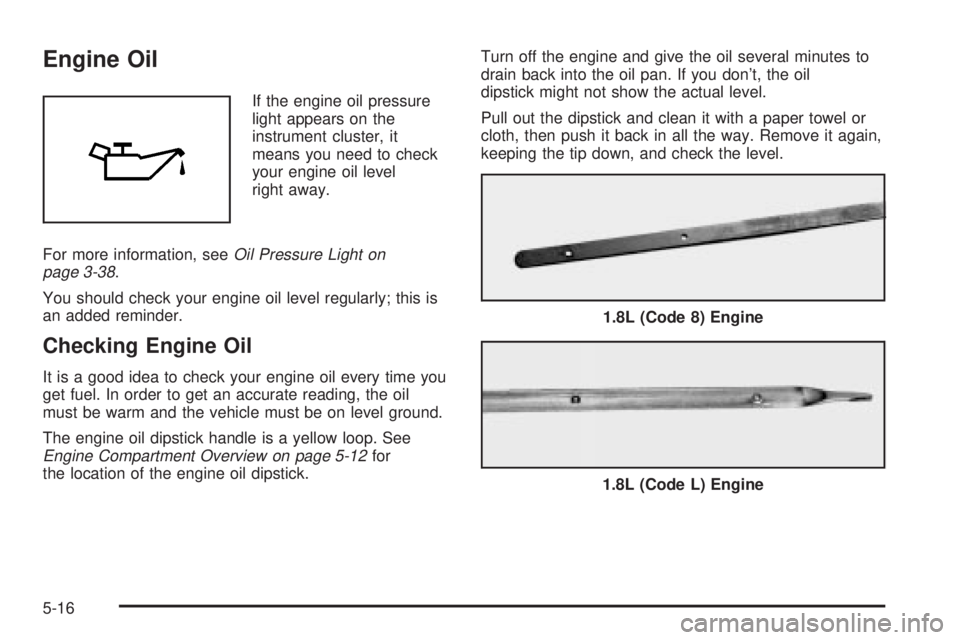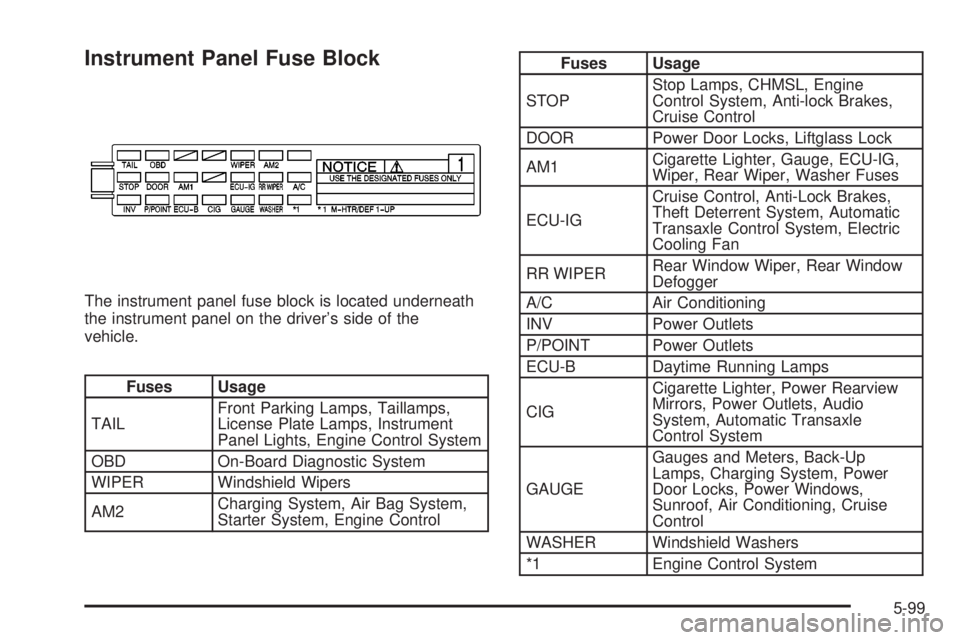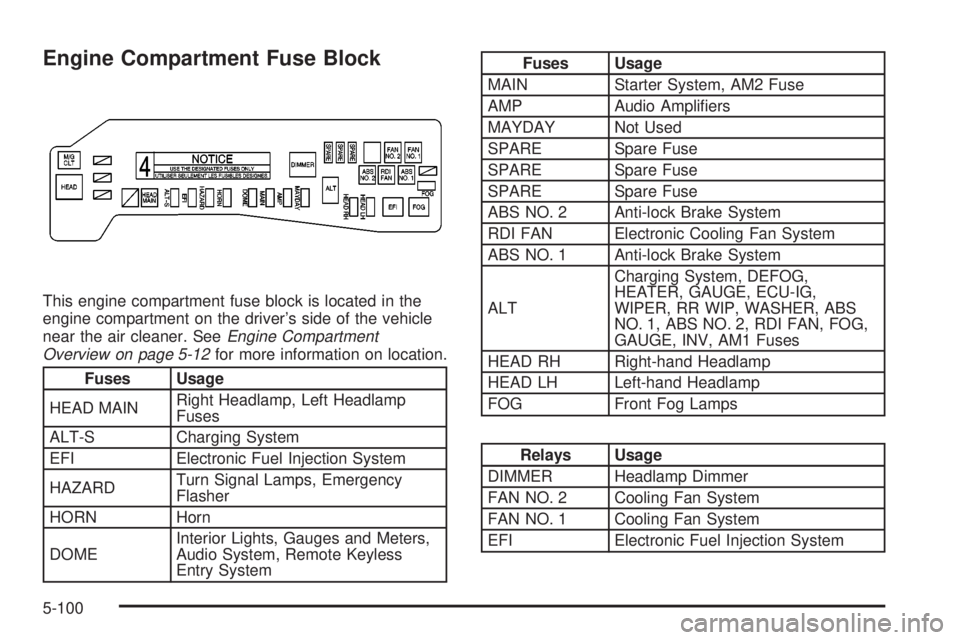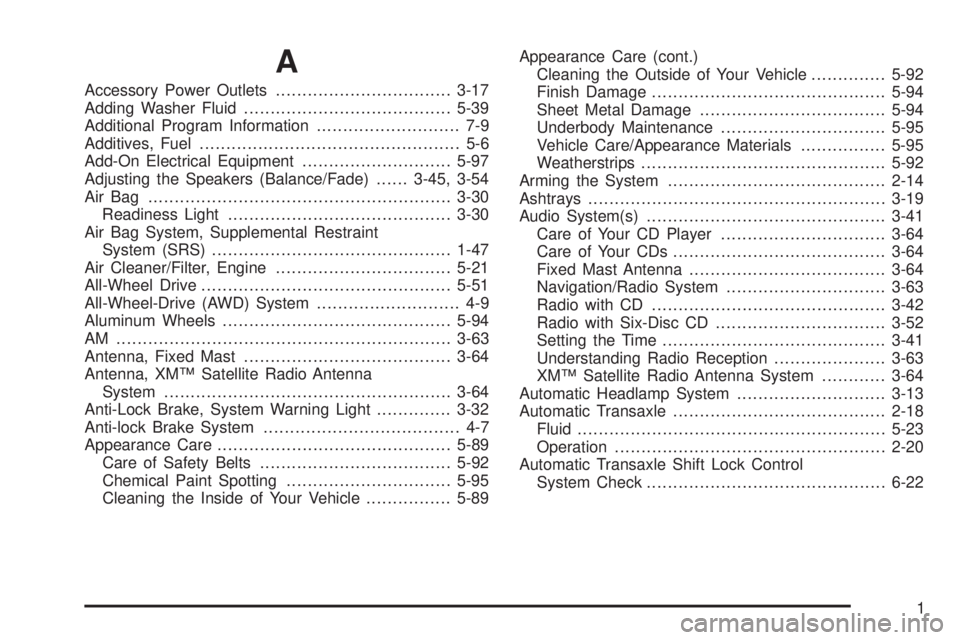Engine light PONTIAC VIBE 2004 Owner's Manual
[x] Cancel search | Manufacturer: PONTIAC, Model Year: 2004, Model line: VIBE, Model: PONTIAC VIBE 2004Pages: 370, PDF Size: 2.68 MB
Page 198 of 370

If You Are Stuck: In Sand, Mud, Ice
or Snow
In order to free your vehicle when it is stuck, you will
need to spin the wheels, but you don't want to spin your
wheels too fast. The method known as ªrockingº can
help you get out when you're stuck, but you must
use caution.
{CAUTION:
If you let your tires spin at high speed, they
can explode, and you or others could be
injured. And, the transaxle or other parts of the
vehicle can overheat. That could cause an
engine compartment ®re or other damage.
When you are stuck, spin the wheels as little
as possible. Do not spin the wheels above
35 mph (55 km/h) as shown on the
speedometer.
Notice:Spinning your wheels can destroy parts of
your vehicle as well as the tires. If you spin the
wheels too fast while shifting your transaxle back
and forth, you can destroy your transaxle. See
ªRocking Your Vehicle To Get It Out.º
For information about using tire chains on your vehicle,
see
Tire Chains on page 5-75.
Rocking Your Vehicle To Get It Out
First, turn your steering wheel left and right. That will
clear the area around your front wheels. Then shift back
and forth between REVERSE (R) and a forward gear
(or with a manual transaxle, between FIRST (1) or
SECOND (2) and REVERSE (R)), spinning the wheels
as little as possible. Release the accelerator pedal
while you shift, and press lightly on the accelerator pedal
when the transaxle is in gear. By slowly spinning your
wheels in the forward and reverse directions, you
will cause a rocking motion that may free your vehicle.
If that doesn't get you out after a few tries, you may
need to be towed out. Or, you can use your recovery
hook. If you do need to be towed out, see
Towing Your
Vehicle on page 4-30.
4-28
Page 226 of 370

Engine Oil
If the engine oil pressure
light appears on the
instrument cluster, it
means you need to check
your engine oil level
right away.
For more information, see
Oil Pressure Light on
page 3-38.
You should check your engine oil level regularly; this is
an added reminder.
Checking Engine Oil
It is a good idea to check your engine oil every time you
get fuel. In order to get an accurate reading, the oil
must be warm and the vehicle must be on level ground.
The engine oil dipstick handle is a yellow loop. See
Engine Compartment Overview on page 5-12for
the location of the engine oil dipstick.Turn off the engine and give the oil several minutes to
drain back into the oil pan. If you don't, the oil
dipstick might not show the actual level.
Pull out the dipstick and clean it with a paper towel or
cloth, then push it back in all the way. Remove it again,
keeping the tip down, and check the level.
1.8L (Code 8) Engine
1.8L (Code L) Engine
5-16
Page 237 of 370

When to Check and What to Use
Refer to the Maintenance
Schedule to determine
how often you should
check the ¯uid level in your
master cylinder reservoir
and for the proper
¯uid. See
Part B: Owner
Checks and Services
on page 6-19
andPart D:
Recommended Fluids
and Lubricants on
page 6-26
.
How to Check and Add Fluid
Check to make sure that the ¯uid level is at or above
the MIN mark. If the level is below the MIN mark,
see the instructions on the reservoir cap.
Engine Coolant
The following explains your cooling system and how to
add coolant when it is low. If you have a problem
with engine overheating, see
Engine Overheating on
page 5-30.
A 50/50 mixture of clean, drinkable water and the proper
coolant will:
·Give freezing protection down to-34ÉF (-37ÉC).
·Give boiling protection up to 265ÉF (129ÉC).
·Protect against rust and corrosion.
·Help keep the proper engine temperature.
·Let the warning lights and gages work as they
should.
5-27
Page 249 of 370

Windshield Washer Fluid
What to Use
When you need windshield washer ¯uid, be sure to read
the manufacturer's instructions before use. If you will
be operating your vehicle in an area where the
temperature may fall below freezing, use a ¯uid that has
sufficient protection against freezing. See
Engine
Compartment Overview on page 5-12for reservoir
location.
Adding Washer Fluid
The low windshield washer
¯uid level warning light will
come on when the ¯uid
level is too low. See
Low Washer Fluid Warning
Light on page 3-39.The windshield washer
¯uid reservoir is located in
the engine compartment
on the passenger's side of
the vehicle.
Open the cap with the washer symbol on it. Add
washer ¯uid until the tank is full.
Canada Only
5-39
Page 251 of 370

So, it is not a good idea to ªtop offº your brake ¯uid.
Adding brake ¯uid will not correct a leak. If you add ¯uid
when your linings are worn, then you will have too
much ¯uid when you get new brake linings. You should
add (or remove) brake ¯uid, as necessary, only when
work is done on the brake hydraulic system.
{CAUTION:
If you have too much brake ¯uid, it can spill on
the engine. The ¯uid will burn if the engine is
hot enough. You or others could be burned,
and your vehicle could be damaged. Add brake
¯uid only when work is done on the brake
hydraulic system.When your brake ¯uid falls to a low level, your brake
warning light will come on. SeeBrake System Warning
Light on page 3-31. United States
Canada
5-41
Page 256 of 370

Notice:If you leave your radio on, it could be badly
damaged. The repairs wouldn't be covered by
your warranty.
3. Turn off the ignition on both vehicles. Unplug
unnecessary accessories plugged into the cigarette
lighter. Turn off the radio and all lamps that aren't
needed. This will avoid sparks and help save
both batteries. And it could save your radio!
4. Open the hoods and locate the batteries. Find the
positive (+) and negative (-) terminal locations on
each vehicle. See
Engine Compartment Overview
on page 5-12for more information on location.
{CAUTION:
An electric fan can start up even when the
engine is not running and can injure you. Keep
hands, clothing and tools away from any
underhood electric fan.
{CAUTION:
Using a match near a battery can cause battery
gas to explode. People have been hurt doing
this, and some have been blinded. Use a
¯ashlight if you need more light.
Be sure the battery has enough water. You
don't need to add water to the battery installed
in your new vehicle. But if a battery has ®ller
caps, be sure the right amount of ¯uid is there.
If it is low, add water to take care of that ®rst.
If you don't, explosive gas could be present.
Battery ¯uid contains acid that can burn you.
Don't get it on you. If you accidentally get it in
your eyes or on your skin, ¯ush the place with
water and get medical help immediately.
5-46
Page 309 of 370

Instrument Panel Fuse Block
The instrument panel fuse block is located underneath
the instrument panel on the driver's side of the
vehicle.
Fuses Usage
TAILFront Parking Lamps, Taillamps,
License Plate Lamps, Instrument
Panel Lights, Engine Control System
OBD On-Board Diagnostic System
WIPER Windshield Wipers
AM2Charging System, Air Bag System,
Starter System, Engine Control
Fuses Usage
STOPStop Lamps, CHMSL, Engine
Control System, Anti-lock Brakes,
Cruise Control
DOOR Power Door Locks, Liftglass Lock
AM1Cigarette Lighter, Gauge, ECU-IG,
Wiper, Rear Wiper, Washer Fuses
ECU-IGCruise Control, Anti-Lock Brakes,
Theft Deterrent System, Automatic
Transaxle Control System, Electric
Cooling Fan
RR WIPERRear Window Wiper, Rear Window
Defogger
A/C Air Conditioning
INV Power Outlets
P/POINT Power Outlets
ECU-B Daytime Running Lamps
CIGCigarette Lighter, Power Rearview
Mirrors, Power Outlets, Audio
System, Automatic Transaxle
Control System
GAUGEGauges and Meters, Back-Up
Lamps, Charging System, Power
Door Locks, Power Windows,
Sunroof, Air Conditioning, Cruise
Control
WASHER Windshield Washers
*1 Engine Control System
5-99
Page 310 of 370

Engine Compartment Fuse Block
This engine compartment fuse block is located in the
engine compartment on the driver's side of the vehicle
near the air cleaner. See
Engine Compartment
Overview on page 5-12for more information on location.
Fuses Usage
HEAD MAINRight Headlamp, Left Headlamp
Fuses
ALT-S Charging System
EFI Electronic Fuel Injection System
HAZARDTurn Signal Lamps, Emergency
Flasher
HORN Horn
DOMEInterior Lights, Gauges and Meters,
Audio System, Remote Keyless
Entry System
Fuses Usage
MAIN Starter System, AM2 Fuse
AMP Audio Ampli®ers
MAYDAY Not Used
SPARE Spare Fuse
SPARE Spare Fuse
SPARE Spare Fuse
ABS NO. 2 Anti-lock Brake System
RDI FAN Electronic Cooling Fan System
ABS NO. 1 Anti-lock Brake System
ALTCharging System, DEFOG,
HEATER, GAUGE, ECU-IG,
WIPER, RR WIP, WASHER, ABS
NO. 1, ABS NO. 2, RDI FAN, FOG,
GAUGE, INV, AM1 Fuses
HEAD RH Right-hand Headlamp
HEAD LH Left-hand Headlamp
FOG Front Fog Lamps
Relays Usage
DIMMER Headlamp Dimmer
FAN NO. 2 Cooling Fan System
FAN NO. 1 Cooling Fan System
EFI Electronic Fuel Injection System
5-100
Page 357 of 370

A
Accessory Power Outlets.................................3-17
Adding Washer Fluid.......................................5-39
Additional Program Information........................... 7-9
Additives, Fuel................................................. 5-6
Add-On Electrical Equipment............................5-97
Adjusting the Speakers (Balance/Fade)......3-45, 3-54
Air Bag .........................................................3-30
Readiness Light..........................................3-30
Air Bag System, Supplemental Restraint
System (SRS).............................................1-47
Air Cleaner/Filter, Engine.................................5-21
All-Wheel Drive...............................................5-51
All-Wheel-Drive (AWD) System........................... 4-9
Aluminum Wheels...........................................5-94
AM ...............................................................3-63
Antenna, Fixed Mast.......................................3-64
Antenna, XMŸ Satellite Radio Antenna
System......................................................3-64
Anti-Lock Brake, System Warning Light..............3-32
Anti-lock Brake System..................................... 4-7
Appearance Care............................................5-89
Care of Safety Belts....................................5-92
Chemical Paint Spotting...............................5-95
Cleaning the Inside of Your Vehicle................5-89Appearance Care (cont.)
Cleaning the Outside of Your Vehicle..............5-92
Finish Damage............................................5-94
Sheet Metal Damage...................................5-94
Underbody Maintenance...............................5-95
Vehicle Care/Appearance Materials................5-95
Weatherstrips..............................................5-92
Arming the System.........................................2-14
Ashtrays........................................................3-19
Audio System(s).............................................3-41
Care of Your CD Player...............................3-64
Care of Your CDs........................................3-64
Fixed Mast Antenna.....................................3-64
Navigation/Radio System..............................3-63
Radio with CD............................................3-42
Radio with Six-Disc CD................................3-52
Setting the Time..........................................3-41
Understanding Radio Reception.....................3-63
XMŸ Satellite Radio Antenna System............3-64
Automatic Headlamp System............................3-13
Automatic Transaxle........................................2-18
Fluid..........................................................5-23
Operation...................................................2-20
Automatic Transaxle Shift Lock Control
System Check.............................................6-22
1
Page 358 of 370

B
Backing Up....................................................4-38
Battery..........................................................5-44
Battery Replacement......................................... 2-6
Before Leaving on a Long Trip.........................4-21
Body Lubrication Service..................................6-21
Brake............................................................2-27
Parking......................................................2-27
System Inspection.......................................6-25
System Warning Light..................................3-31
Brake Fluid....................................................5-40
Brake Wear...................................................5-43
Brakes..........................................................5-40
Braking........................................................... 4-6
Braking in Emergencies..................................... 4-9
Break-In, New Vehicle.....................................2-16
Bulb Replacement...........................................5-52
Back-Up Lamps...........................................5-58
Center High-Mounted Stoplamp (CHMSL)........5-55
Front Turn Signal Lamps..............................5-54
Halogen Bulbs............................................5-52
Headlamps.................................................5-52
Rear Combination Lamps.............................5-56
Replacement Bulbs......................................5-59
Buying New Tires...........................................5-71
C
California Fuel.................................................. 5-5
Canada ± Customer Assistance.......................... 7-5
Canadian Owners................................................ ii
Canadian Roadside Assistance........................... 7-8
Capacities and Speci®cations..........................5-101
Carbon Monoxide.....................4-24, 4-34, 2-9, 2-33
Care of.........................................................5-92
Safety Belts................................................5-92
Your CD Player...........................................3-64
Your CDs ...................................................3-64
Cargo Cover..................................................2-41
Cargo Tie Downs............................................2-41
Carrier Assembly-Differential
(Rear Drive Module)....................................5-51
Center Console Storage Area...........................2-37
Center High-Mounted Stoplamp (CHMSL)...........5-55
Chains, Tires..................................................5-75
Charging System Light....................................3-31
Check...........................................................3-34
Engine Light...............................................3-34
Checking Coolant............................................5-28
Checking Engine Oil........................................5-16
Checking Things Under the Hood......................5-10
Checking Your Restraint Systems......................1-56
Chemical Paint Spotting...................................5-95
2